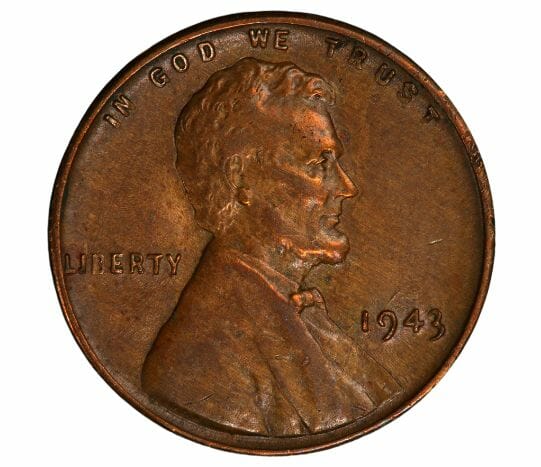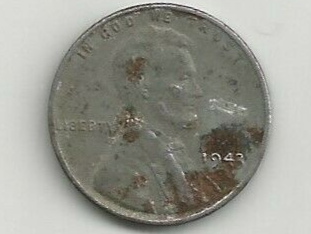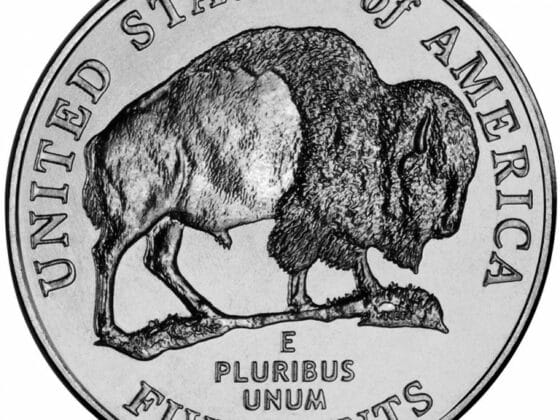Within the world of coin collecting, the 1943 Wheat Penny stands out, captivating both historians and aficionados. This diminutive coin symbolizes a defining juncture in American numismatics, as copper was set aside in response to World War II’s demands.
This transition from a revered copper tradition to a wartime imperative changed the coin’s makeup and gave birth to rare and legendary specimens.
This article explores the genesis, narrative, design, and unparalleled value of the 1943 pennies, shedding light on astonishing minting anomalies that have mesmerized collectors and numismatists alike.
Table of Contents
The Origin and History of The 1943 Penny
The tale of the 1943 Wheat Penny is woven with threads of war, national pride, and fortuity. As the 1940s dawned and World War II raged on, the United States, joining the Allies against the Axis powers, faced a critical need for resources.
Copper, essential for electrical wiring, ammunition, and other wartime necessities, became a precious commodity, leading to scarcity in several industries, including coin production.
To conserve copper for the war effort — enough to produce 1.25 million ammunition shells — a shift was made towards alternative materials like zinc and steel for coinage, prompting a metamorphosis in the penny’s makeup and heralding the emergence of the 1943 Wheat Penny.
The US Mint in 1943

With scarce copper, the US Mint 1943 began producing wheat pennies with copper-covered steel cores. The aim was to save on metals needed for the war effect and support the country’s economic stability during tumultuous times. However, some copper pennies were mistakenly minted, making them some of the most valuable coins.
The Coinage Act of 1943
In response to the scarcity of copper, the Coinage Act of 1943 authorized the use of alternative metals for particular denominations, notably the cent. It was during this year that the penny underwent a significant transformation. Steel and zinc emerged as the primary materials to replace traditional copper.
Why Copper Was Crucial for War
Copper, renowned for its superior conductivity and malleability, played a pivotal role in the wartime effort. Essential for building radar systems, crafting ammunition shell casings, and manufacturing military vehicles, conserving this metal became paramount in supporting the troops at the forefront of battle.
The 1943 Penny Design, Composition, and Dimensions
Steel Pennies from 1943 were designed by Victor D. Brenner, a Lithuanian sculptor, during World War II due to copper shortage. He also designed the original Lincoln Cent series in 1909. Let’s explore the simple yet iconic design of the 1943 Penny:
Obverse Side

The 1943 Wheat Penny’s obverse features a portrait of Abraham Lincoln, the 16th US President, in a suit facing right. Above his head, along the coin’s edge, is the inscription “IN GOD WE TRUST,” and the word “LIBERTY” is inscribed to the left. Embossed on the right and below Lincoln’s chin is the coin’s mint year, “1943.”
Reverse Side

The flip side of the penny prominently features the denomination “ONE CENT” at its core. Below this, the phrase “UNITED STATES OF AMERICA” is inscribed in a more refined font. Flanking both sides of these inscriptions are twin wheat stalks, giving rise to the moniker “Wheat Penny.” Crowning the top rim is the Latin adage, “E PLURIBUS UNUM,” translating to “Out of many, one.
1943 Wheat Penny Composition & Dimensions
The 1943 Wheat Penny was notably different from its predecessors due to the wartime demand for copper. As a result, its composition and physical characteristics were altered:
Composition
- 1943 Steel Wheat Penny: Made primarily of steel and coated with zinc. Unlike previous pennies made predominantly of copper.
Dimensions and Weight:
- Diameter: 19 millimeters (0.75 inches)
- Thickness: 1.55 millimeters (0.061 inches)
- Weight: 2.7 grams (This is lighter than the typical copper penny, which weighs 3.11 grams.)
Note: The above details pertain to the steel version of the 1943 Wheat Penny, which was the most common type minted that year. However, a very limited number of 1943 pennies were mistakenly struck on copper planchets, making them extremely rare and valuable. The copper versions retain the weight and dimensions consistent with earlier copper pennies, weighing 3.11 grams.
1943 Steel Penny

As the name suggests, 1943 Steel Pennies contain 99% steel with a 1% zinc coating. These pennies have a silver appearance, measuring 19.05 mm wide and weighing 2.702 grams. They are also 1.55 mm thick.
1943 Copper Penny

A few 1943 copper pennies were mistakenly struck on copper planchets from the previous year. These cents comprised 95% copper and 5% zinc, making them exceedingly rare and precious. They weigh 2.5 grams and have a diameter of 19.05mm.
1943 Bronze Penny

Experimental bronze 1943 pennies were struck as proof. This further enhanced their value and rarity. While not technically errors, these bronze pennies are scarce and highly sought after by collectors.
The 1943 Value & Rare Errors
The value of 1943 Wheat Pennies varies based on several elements, such as their condition, material composition, and any unique minting errors. While they might fetch between 15 to 30 cents in lower-grade circulated conditions, those graded MS66 or above command a significant premium due to their rarity. For instance, a 1943 Steel Penny once fetched an impressive $218,500 at auction.
1943 Copper Penny Value

The most famous error for this year is the 1943 penny struck on a copper planchet. This mistake occurred when a few leftover copper planchets from the previous year were accidentally used. These pennies can be worth a significant sum, depending on their condition.
1943-S Copper Penny
Even rarer than the regular 1943 copper penny is the 1943-S version minted at the San Francisco Mint. Only a few are known to exist, making them exceptionally valuable.
1943-D Copper Penny
Struck at the Denver Mint, this is one of the rarest varieties of the 1943 penny, with very few known examples. The scarcity of these coins adds to their desirability among collectors.
1943 Copper Penny $1.7 Million Myth or Reality?
In 2010, a 1943 copper penny, graded MS-63 Red-Brown by PCGS, sold for a staggering $1.7 at an auction. This colossal sale made headlines in the numismatic world and demonstrated the error’s incredible value.
The same penny was resold for $840,000 in 2021. While other mintage series of this error coin have fetched six-figure amounts, the 1943 copper remains the most valuable and paid-for penny.
1943 Steel Penny Value
The US Mint produced over 600,000 Lincoln Wheat Pennies in 1943, a relatively large mintage. So, it’s safe to say the penny is quite common in numismatic terms. These pennies are worth between 15 and 30 cents in poor circulated condition.
However, specimens in higher grades can fetch a significant amount. The 1943 Steel Penny’s auction price record stands at $218,500. The exact value of 1943 Steel Pennies varies based on their condition and other characteristics they possess.
1943 Steel Penny Chart
| Series | MS67 | MS68 | MS68+ |
| 1943 Steel Penny | $200 | $5,000 | $35,000 |
| 1943 D Steel Penny | $250 | $3,100 | $15,500 |
| 1943 S Steel Coin | $285 | $3,500 | $35,000 |
Most Common 1943 Penny Errors & Their Associated Values
Here are some notable 1943 Penny errors and their associated values:
Double Die Error

Some 1943 steel pennies exhibit doubling on the obverse side, where the letters and numbers appear twice, slightly offset from their primary images. This is a result of the die that struck the coin improperly prepared. These errors can be worth several hundred dollars or more, depending on their visibility. In 2011, a specimen-graded MS67 sold for a record price of $21,275 at Heritage Auction.
Off-Center Strikes

Some 1943 pennies were struck off-center, meaning the images on the head and tail sides do not align perfectly with the coin’s center. The value of these errors depends on how off-center the strike is, with more dramatic misalignments commanding higher prices. A low off-strike 1943 penny can fetch up to $150.
Clipped Planchets

Occasionally, a penny planchet would be clipped during the minting process, resulting in a coin missing a small portion of its edge. These clipped planchet errors can add value to the coin, mainly if the clip is prominent.
Lamination Errors

Lamination errors occur when impurities in the steel or the zinc coating cause parts of the coin to peel away or separate. The presence and extent of these errors can significantly affect the coin’s value, with more severe lamination errors being more valuable.
1943 Bronze Proof Penny

While not technically errors, some experimental bronze 1943 pennies were produced as proofs. These coins are exceedingly rare and highly sought after by collectors. Their unique composition and historical significance make them prized additions to any collection.
Conclusion
The 1943 Wheat Penny’s evolution from a wartime necessity to a sought-after collectible showcases the adaptability of American coinage. Its significant mintage adds to its collectible charm. For both avid numismatists and casual collectors, these pennies provide a unique window into a crucial historical era, their auction values underscoring their status as enduring symbols of wartime sacrifice and numismatic gems.











